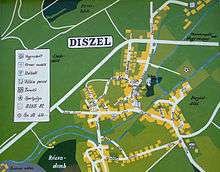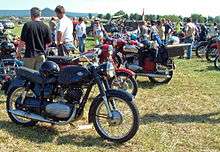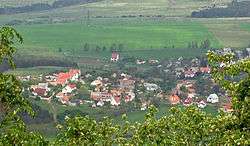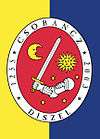Diszel
| Tapolca-Diszel | ||
|---|---|---|
|
View of Diszel from the top of Csobánc | ||
| ||
 Tapolca-Diszel Location of Diszel | ||
| Coordinates: 46°53′10″N 17°29′40″E / 46.88611°N 17.49444°ECoordinates: 46°53′10″N 17°29′40″E / 46.88611°N 17.49444°E | ||
| Country |
| |
| County | Veszprém | |
| Time zone | CET (UTC+1) | |
| • Summer (DST) | CEST (UTC+2) | |
| Postal code | 8297 | |
| Area code(s) | 87 | |
| Website | http://www.diszel.hu/ | |
Diszel (Tapolica Diszel [ˈtɒpoltsɒ ˈdisɛl]) is a village in Veszprém county, Hungary, merged with the town of Tapolca administratively since 1977. Situated in the Tapolca Basin, Diszel is rich in spectacular geological heritages and historical monuments. Diszel is considered as one of the most beautiful areas of the country.[1]
History
The history of Diszel dates back as early as the Roman Times. The area was part of Pannonia province of the Roman Empire. By popular etymology, the name Diszel derived from the Hungarian expression “Díszhely” [ˈdiːshɛj] (decoration-place), referring to its beauty. In fact, the name comes from a personal name, in a typical Hungarian way, but the actual person and his role in local history is unknown. The name was first mentioned in 1247.[2]

Although the settlement has been home for agriculturers and farmers for hundreds of years, it is important from the cultural point of view as well. Several artists live in and around Diszel. Even celebrities find retreat in these hills and spend several months here each year.
Poet and literary historian István Péter Németh from Tapolca wrote several poems and articles on Diszel and its surroundings, including “Diszel 1848”,[3] “Drawing-board is my professorate”,[4] “Greeting from Csobánc”,[5] and “The Requiem of Csobánc”.[6]
Diszel lost its municipal independence as a village in 1977 when it was merged with the nearby town of Tapolca. Since then it has been referred to as Tapolca-Diszel in some cases. (In Hungarian this means "Diszel belonging to Tapolca" rather than "Tapolca and Diszel merged".)
Geography
Diszel is in the Tapolca Basin surrounded by hills of volcanic origin. The area is part of the Balaton Uplands National Park.[7] Its proximity to Lake Balaton makes Diszel an ideal destination for both tourers and travellers.
Notable sights

In spite of the relatively small size of the settlement it offers much to see. There are several architectural treasures, including ancient monuments, old watermill ruins, sculptures and exhibitions. There is a museum and two galleries in Diszel. Dating back to the 18th century, a narrow stone bridge overlaps the banks of Eger Creek in the center. The backyard of the Local Community Centre gives place to a sculpture exhibition. Several grave monuments of nobles as well as memorials from World War II are placed in the cemetery. In Diszel there is a riding-hall called “Lightning” (Villám Lovaspanzió [ˈvillaːm ˈlovɒʃpɒnzioː]). Riding tours are organized to the hill Csobánc which is a nice destination not only for equestrians but hikers and paragliders as well. On the top of the hill there are the castle ruins that survived the last few centuries.
“Roman bridge”
The “Roman bridge” of Diszel has been ordered by the then Zala county. The bridge that can be seen today has been built in summer 1793 by stonemason Károly Schraz from Sümeg.[8]
Sculpture of St. John of Nepomuk
The sculpture of the patron saint of Bohemia, St. John of Nepomuk can be found on the “Roman bridge” of Diszel.
Church
The original church of Diszel had been built in the 13th century, however, it has been destroyed by the Turks during the Ottoman–Hungarian Wars.
The church of the vicarage was built in the 18th century, preserving carvings from the Roman Times.
The organ of the church was built in the late 19th century, is still functional and used during masses.
World War I Monument
In the center there is a monument of World War I soldiers. 52 names are listed.
First Hungarian Spectacle Repository
The “First Hungarian Spectacle Repository” (Első Magyar Látványtár [ˈɛlʃøː ˈmɒɟɒr ˈlaːtvaːɲtaːr]) is the museum of Diszel. It provides exhibitions on various topics in every 2–3 years. Situated in the reconstructed building of an old watermill, the museum has a cheerful cafe and a large yard with the Csobánc in the background. It is an ideal place for literary premiere and musical performances.
Tisza-Kalmár Gallery
Tisza-Kalmár Galéria [ˈtisɒ ˈkɒlmaːr ˈɡɒleːriɒ] is the gallery of the artist György Tisza-Kalmár. He is a polyhistor with a wide range of artwork, including drawings, paintings, graphic arts, Coat of Arms, and woodcrafts.[9] The exhibition room can be found in the proximity of the church.
Retro Exchange Gallery
The “Retro Exchange Gallery” (Retro Anyagcsere Galéria [ˈrɛtro ˈɒɲɒɡtʃɛrɛ ˈɡɒleːriɒ]) was opened in 2009. It is a constantly changing collection of artwork, tools, and old-fashioned clothers that can be exchanged for other “treasures”.[10]

The castle ruins of “Csobánc”
The closest hill to the South is called Csobánc [ˈtʃobaːnts] with a height of 376 m. A tourist path leads from the village to the castle ruins. Due to its thermodinamic features it is an ideal spot for paragliding and ultralight trikes. Hiking and geocaching are also popular activities around the area.
Associations
The Sport Association of Diszel
Diszel has a football team. Their colors, yellow and blue, are represented also on the Coat of arms of Diszel.
Talented Youth Association Diszel
The “Talented Youth Association Diszel” (Talentum Ifjúsági Egyesület Diszel [ˈtɒlɛntum ˈifjuːʃaːɡi ˈɛɟɛʃylɛt]) is a popular team of enthusiastic, devoted youngsters. The name is some kind of agnomination since TIED is not just the abbreviation of the official name but has the meaning 'yours'. TIED often contributes to various community activities either as a participant or organizer, including several programmes, the annual grape harvest festival, or creek bank cleaning. The major aims of the association are[11]
- Collection and transmission of folk art and cultural values, including spiritual, musical, dance and architectural traditions
- Organization of youth programmes, including artistic and sports programmes, travelling, hiking, theatricals, concerts, and exhibitions
- Tradition preservation
- Protection of natural treasures of the Balaton Uplands
- Encouragement of amateur artists and artistic activities
In 2010, TIED published a DVD on Diszel as a participant of the European Union project 'Youth in Action'.[12]
“Corrosion Removers”

The local oldtimer club Association of Oldtimers “Corrosion Removers” (Rozsdamarók Veteránjármű Egyesülete [[Help:IPA for Hungarian|[ˈroʒdɒmɒroːk ˈvɛtɛraːnjaːrmyː ]]ˈɛɟɛʃylɛtɛ]) was founded in 2000. A tradational oldtimer motorcycle meeting is held around Midsummer Day annually. Additionally, tours are organized throughout the year. Media appearances are frequent, especially in the press. Video recordings, including DVDs and YouTube videos, are authored by their Webmaster Leslie Sikos. The association has international reputation.[13]
References
- ↑ Katalin Avar, ed. (2005). Csodaszép Magyarország. Reader's Digest. ISBN 978-9639562295.
- ↑ "Official website of Diszel'".
- ↑ "Diszel 1848". Retrieved 2010-07-27.
- ↑ "Drawing-board is my professorate". 2002. Retrieved 2010-07-27.
- ↑ "Greeting from Csobánc". 2002. Retrieved 2010-07-27.
- ↑ Csobánci rekviem. Németh István Péter. 2010. p. 50. ISBN 978-963-8365-80-4.
- ↑ "Balaton-felvidéki Nemzeti Park".
- ↑ "A hídépítés fejezetei".
- ↑ "Tisza-Kalmár György festőművész".
- ↑ "Mágika Tanyája".
- ↑ "Talentum Ifjúsági Egyesület Diszel".
- ↑ "TIED - Talentum Ifjúsági Egyesület Diszel".
- ↑ "Association of Oldtimers Corrosion Removers". 10 April 2010.

